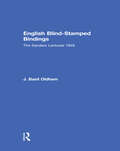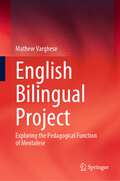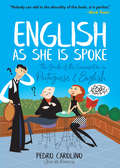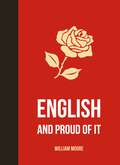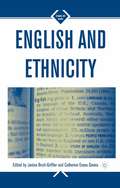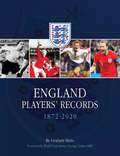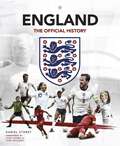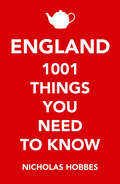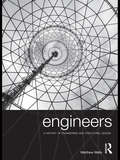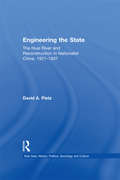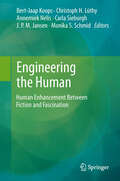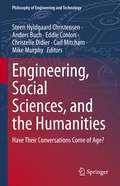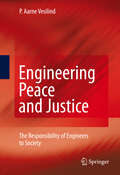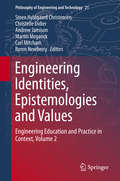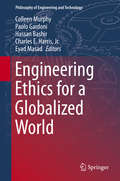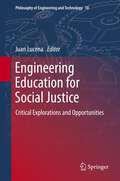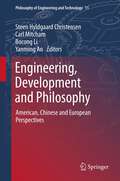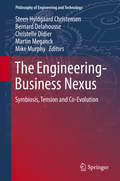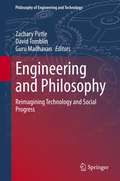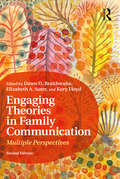- Table View
- List View
English Blind Stamped
by J. Basil OldhamThis book of the Sandar Lectures for 1949 confines itself to English blind-stamped bindings of the fifteenth, sixteenth and seventeenth centuries. Oldham, an authority on his subject, here describes his methods of study, and accounts for many groups of bindings that may be attributed to particular craftsmen or binderies. Oldham's experience includes all important English collections, His book devises a method of ornament-classification and description and is illustrated by 61 plates. A study of the tools used on blind-stamped bindings in England between the fifteenth and seventeenth centuries.
English Blind Stamped
by J. Basil OldhamThis book of the Sandar Lectures for 1949 confines itself to English blind-stamped bindings of the fifteenth, sixteenth and seventeenth centuries. Oldham, an authority on his subject, here describes his methods of study, and accounts for many groups of bindings that may be attributed to particular craftsmen or binderies. Oldham's experience includes all important English collections, His book devises a method of ornament-classification and description and is illustrated by 61 plates. A study of the tools used on blind-stamped bindings in England between the fifteenth and seventeenth centuries.
English Bilingual Project: Exploring the Pedagogical Function of Mentalese
by Mathew VargheseToday, English is the global lingua franca and competent English communication skills should be one of the rights of all educated individuals irrespective of any socio-cultural limits. By introducing a new method, this book focuses on helping any learner to get sufficient communication skills in English as much as in the native language. This method helps one to avoid translating from mother tongue to English. And by using the method of thinking in English, one could acquire the required English bilingual skills naturally. The method is founded on the philosophical idea of mentalese—mind language as the base language of thinking available for humans for constructing thoughts. The proposed English Bilingual Project (EBP) helps one to transfer thoughts from a structureless mentalese to the grammatical structure of any language English/Japanese/Chinese. The method described in this book works in two ways: one it helps one to intuitively understand the working of mentalese; the other is by practicing think in English with the mentalese, one could generate the bilingual brain. The main procedure for transferring thoughts from the mentalese to English is through writing one’s thoughts. This helps one to think effectively in English like one’s own mother tongue. This method works as a prime requirement model for one to generate multilingual skills. The book resourced the idea of mentalese from the classical philosophy, reflects it with the modern generative theories, links it with the studies in neuro-linguistic studies on bilingualism and the bilingual brain.
English as She Is Spoke: The Guide of the Conversation in Portuguese and English
by Mark Twain Pedro CarolinoThe Guide of the Conversation in Portuguese and English
English as an Additional Language: Key Features of Practice (PDF)
by Liz Haslam Yvonne Wilkin Edith Kellet400MB+ file - please request from RNIB Bookshare directly. English as an Additional Language is packed full of straightforward ideas to help teachers get a grip on good classroom practice and will help teachers: understand language development and its impact upon pupils attainment use the latest teaching strategies and interventions to help pupils access the curriculum and enjoy all aspects of school life anticipate problems for later-stage pupils and be ready to support their independence keep up-to-date with the DfES English as an Additional Language Strategy and Race Relations Act Amendments.
English and Proud of It
by William MooreEngland is loved for its beautiful landscapes, its great sporting history and for being the birthplace of celebrated figures such as William Shakespeare and Florence Nightingale. Celebrate your roots and explore some of England's most fascinating facts and charming quotes in this miscellany fit for any lover of this green and pleasant land.
English and Ethnicity (Signs of Race)
by J. Brutt-Griffler C. Evans Davies Catherine Evans DaviesThis volume examines the complex interaction between the English language and the construction of ethnicity in the global English-speaking world. The essays demonstrate that the constructs of both English and ethnicity are contested sites of identity formation.
England Players' Records: 1872 - 2020
by Graham BettsIt has been some ten years since the first edition of England Players’ Records was published, during which time more than 100 players have been capped for the national side on at least one occasion. During that same time frame, no fewer than five players have joined the exalted ranks of centurions by winning their one hundredth cap. Now comprehensively updated, the book contains details of each and every footballer who has played for England, 1235 in total, including all the squad players who took part in the FIFA World Cup in Russia under new manager Gareth Southgate. Compiled by Graham Betts, the leading expert on England’s football team, the Players’ Records includes a foreword by World Cup winning full-back George Cohen who celebrated his 80th birthday in October 2019.
England: The Official History
by Daniel Storey The FAThe complete, official history of the England football team as you've never seen it before! England: The Official History is a fascinating account of the world's oldest and most iconic national football team.• Includes England's fantastic performance at EURO 2020. • A great gift for any England fan. • Features more than 250 exceptional photographs of England icons past and present including Alf Ramsey, Bobby Charlton, Gary Lineker, Hope Powell, David Beckham, Steph Houghton and Harry Kane. • The complete story of the England men's and women's teams – from 1872 right up to the present day. • Written by award-winning journalist and author Daniel Storey in association with the FA and filled with incredible stories spanning 150 years of England football.The book charts the highs (and lows) of the England national teams and the men and women who've worn the Three Lions with pride. Each chapter delves into a specific era, covering key figures, famous and infamous matches, and the evolution of football over the course of more than a century and a half.This is the definitive visual history of English Football.
England: 1,001 Things You Need to Know
by Nicholas HobbesDespite a thousand years of glorious history, the people of England know surprisingly little of the facts and fables, people and places and events and emblems that have shaped their country and its heritage. * Where did John Bull come from? * What is the Long Man of Wilmington? * Who abolished Christmas? * When did roast beef become a national dish? From the White Cliffs of Dover to MG Rover, from Newcastle Brown Ale to Royal Mail, and from John Milton to blue stilton, Nicholas Hobbes explains and celebrates the many facets of Englishness for today's readers. The result is as entertaining as it is essential.
Engineers: A History of Engineering and Structural Design
by Matthew WellsThis innovative new book presents the vast historical sweep of engineering innovation and technological change to describe and illustrate engineering design and what conditions, events, cultural climates and personalities have brought it to its present state. Matthew Wells covers topics based on an examination of paradigm shifts, the contribution of individuals, important structures and influential disasters to show approaches to the modern concept of structure. By demonstrating the historical context of engineering, Wells has created a guide to design like no other, inspirational for both students and practitioners working in the fields of architecture and engineering.
Engineers: A History of Engineering and Structural Design
by Matthew WellsThis innovative new book presents the vast historical sweep of engineering innovation and technological change to describe and illustrate engineering design and what conditions, events, cultural climates and personalities have brought it to its present state. Matthew Wells covers topics based on an examination of paradigm shifts, the contribution of individuals, important structures and influential disasters to show approaches to the modern concept of structure. By demonstrating the historical context of engineering, Wells has created a guide to design like no other, inspirational for both students and practitioners working in the fields of architecture and engineering.
Engineering the State: The Huai River and Reconstruction in Nationalist China, 1927–37 (East Asia: History, Politics, Sociology and Culture)
by David PietzUsing case studies of large-scale public works projects in the Huai River valley of central China, this title illustrates the manner in which the Nationalist governmentst sought to re-establish central administrative control which fractured following the fall of the empire.
Engineering the State: The Huai River and Reconstruction in Nationalist China, 1927–37 (East Asia: History, Politics, Sociology and Culture)
by David PietzUsing case studies of large-scale public works projects in the Huai River valley of central China, this title illustrates the manner in which the Nationalist governmentst sought to re-establish central administrative control which fractured following the fall of the empire.
Engineering the Human: Human Enhancement Between Fiction and Fascination
by Bert-Jaap Koops, Christoph H. Lüthy, Annemiek Nelis, Carla Sieburgh, J. P. M. Jansen and Monika S. SchmidThe volume is collection of articles treating the topic of human improvement/enhancement from a variety of perspectives – philosophical, literary, medical, genetic, sociological, legal etc. The chapters in this volume treat not only those aspects that most immediately come to mind when one thinks of ‘human enhancement’, such as genetic engineering, cloning, artificial implants and artificial intelligence etc. Somewhat less obvious aspects include evolutionary perspectives in connection with the prolongation of the human lifespan, plastic surgery since its beginnings, and questions such as whether the distinction between ‘natural’ and ‘artificial’ can really be drawn at all and how it has been conceived across the ages, or what the legal implications are of recent developments and techniques. Many papers make links to the representation of these developments in popular culture, from Jules Verne through Aldous Huxley to the movie Gattaca, address the hopes and fears that come with them as well as the question how realistic these are. While all chapters are written by scientists at the international top of their respective fields, all are accessible to a non-specialist audience and eminently readable. We believe that they represent a state-of-the art overview of questions that are of interest to a large audience. The book thus targets a non-specialist audience with an interest in philosophical, sociological, scientific and legal issues involved in both traditional and recent matters concerning the desire of mankind to improve itself, the human body, the human mind and the human condition. It is unique in that it brings together all these aspects within a coherent and cohesive collection.
Engineering, Social Sciences, and the Humanities: Have Their Conversations Come of Age? (Philosophy of Engineering and Technology #42)
by Steen Hyldgaard Christensen Anders Buch Eddie Conlon Christelle Didier Carl Mitcham Mike MurphyThis book presents a critical examination of conversations between engineering, social sciences, and the humanities asking whether their conversations have come of age. These conversations are important because ultimately their outcome have real world consequences in engineering education and practice, and for the social and material world we inhabit. Taken together the 21 chapters provide scholarly-argued responses to the following questions.Why are these conversations important for engineering, for social sciences, and for the humanities?Are there key places in practice, in the curriculum, and in institutions where these conversations can develop best?What are the barriers to successful conversations?What proposals can be made for deepening these conversations for the future?How would we know that the conversations have come of age, and who gets to decide?The book appeals to scholarly audiences that come together through their work in engineering education and practice. The chapters of the book probes and access the meetings and conversations, and they explore new avenues for strengthening dialogues that transcend narrow disciplinary confines and divisions.“The volume offers a rich collection of descriptive resources and theoretical tools that will be useful for researchers of engineering practices, and for those aiming to reshape the engineering lifeworld through new policies. The book depicts the current state of the art of the most visible SSH contributions to shaping engineering practices, as well as a map of research gaps and policy problems that still need to be explored.” - Dr. Ir. Lavinia Marin, TU Delft, Electrical Engineering and Philosophy
Engineering Peace and Justice: The Responsibility of Engineers to Society
by P. Aarne VesilindSome years ago when I was chair of the department of civil and environmental engineering, a colleague introduced me to a visitor from Sandia Laboratories, perhaps the largest developer of armaments and weapons systems in the world. We had a nice visit, and as we chatted, the talk naturally centered on the visitor’s engineering work. It turned out that his job in recent years had been to develop a new acoustic triggering device for bombs. As he explained it, the problem with bombs was that the plunger triggering mechanism could fail if the bomb hit at an angle, and thus the explosives would not detonate. To get around this, he dev- oped an acoustic trigger that would detonate the explosives as soon as the bomb hit any solid surface, even at an angle. As he talked, I watched his face. His enthusiasm for his work was clearly e- dent, and his animated explanations of what they had developed at Sandia exuded pride and excitement. I thought about asking him what it felt like to have spent his engineering career designing better ways to kill people or to destroy property – the sole purpose of a bomb. I wondered how many people had been killed because this man had dev- oped a clever acoustic triggering device. But good sense and decorum prevailed and I did not ask him such questions. We parted as friends and in good spirits.
Engineering Identities, Epistemologies and Values: Engineering Education and Practice in Context, Volume 2 (Philosophy of Engineering and Technology #21)
by Steen Hyldgaard Christensen Christelle Didier Andrew Jamison Martin Meganck Carl Mitcham Byron NewberryThis second companion volume on engineering studies considers engineering practice including contextual analyses of engineering identity, epistemologies and values. Key overlapping questions examine such issues as an engineering identity, engineering self-understandings enacted in the professional world, distinctive characters of engineering knowledge and how engineering science and engineering design interact in practice.Authors bring with them perspectives from their institutional homes in Europe, North America, Australia\ and Asia. The volume includes 24 contributions by more than 30 authors from engineering, the social sciences and the humanities. Additional issues the chapters scrutinize include prominent norms of engineering, how they interact with the values of efficiency or environmental sustainability. A concluding set of articles considers the meaning of context more generally by asking if engineers create their own contexts or are they created by contexts.Taken as a whole, this collection of original scholarly work is unique in its broad, multidisciplinary consideration of the changing character of engineering practice.
Engineering Ethics for a Globalized World (Philosophy of Engineering and Technology #22)
by Colleen Murphy Paolo Gardoni Hassan Bashir Charles E. Harris Jr. Eyad MasadThis volume identifies, discusses and addresses the wide array of ethical issues that have emerged for engineers due to the rise of a global economy. To date, there has been no systematic treatment of the particular challenges globalization poses for engineering ethics standards and education. This volume concentrates on precisely this challenge. Scholars and practitioners from diverse national and professional backgrounds discuss the ethical issues emerging from the inherent symbiotic relationship between the engineering profession and globalization. Through their discussions a deeper and more complete understanding of the precise ways in which globalization impacts the formulation and justification of ethical standards in engineering as well as the curriculum and pedagogy of engineering ethics education emerges.The world today is witnessing an unprecedented demand for engineers and other science and technology professionals with advanced degrees due to both the off-shoring of western jobs and the rapid development of non-Western countries. The current flow of technology and professionals is from the West to the rest of the world. Professional practices followed by Western (or Western-trained) engineers are often based on presuppositions which can be in fundamental disagreement with the viewpoints of non-Westerners. A successful engineering solution cannot be simply technically sound, but also must account for cultural, social and religious constraints. For these reasons, existing Western standards cannot simply be exported to other countries.Divided into two parts, Part I of the volume provides an overview of particular dimensions of globalization and the criteria that an adequate engineering ethics framework must satisfy in a globalized world. Part II of the volume considers pedagogical challenges and aims in engineering ethics education that is global in character.
Engineering Education for Social Justice: Critical Explorations and Opportunities (Philosophy of Engineering and Technology #10)
by Juan LucenaHoping to help transform engineering into a more socially just field of practice, this book offers various perspectives and strategies while highlighting key concepts and themes that help readers understand the complex relationship between engineering education and social justice. This volume tackles topics and scopes ranging from the role of Buddhism in socially just engineering to the blinding effects of ideologies in engineering to case studies on the implications of engineered systems for social justice. This book aims to serve as a framework for interventions or strategies to make social justice more visible in engineering education and enhance scholarship in the emerging field of Engineering and Social Justice (ESJ). This creates a ‘toolbox’ for engineering educators and students to make social justice a central theme in engineering education.
Engineering, Development and Philosophy: American, Chinese and European Perspectives (Philosophy of Engineering and Technology #11)
by Steen Hyldgaard Christensen, Carl Mitcham, Bocong Li and Yanming AnThis inclusive, cross-cultural study rethinks the nexus between engineering, development, and culture. It offers diverse commentary from a range of disciplinary perspectives on how the philosophies of today’s cultural triumvirate—American, European and Chinese—are shaped and given nuance by the cross-fertilization of engineering and development. Scholars from the humanities and social sciences as well as engineers themselves reflect on key questions that arise in this relational context, such as how international development work affects the professional views, identities, practice and ethics of engineers. The first volume to offer a systematic and collaborative study that cuts across continental boundaries, the book delineates the kinds of skills and competences that tomorrow’s engineering success stories will require, and analyzes fascinating aspects of the interplay between engineering and philosophy, such as how traditionally Chinese ways of thinking can influence modern engineering practice in the world’s most populous country. China’s problematic mix of engineering woes and wonders, from the high-profile crash on its high-profile rail network to its ‘bird’s nest’ Olympic stadium, adds to the urgency for reform, while Europe’s Enlightenment-informed legal frameworks are contrasted with Chinese mechanisms in their governance of the field of nanotechnology, a crucial element of future technical evolution. Fascinating and compelling in equal measure, this volume addresses one of the topics at the leading edge of humanity’s quest to survive, and to thrive.
The Engineering-Business Nexus: Symbiosis, Tension and Co-Evolution (Philosophy of Engineering and Technology #32)
by Steen Hyldgaard Christensen Christelle Didier Martin Meganck Mike Murphy Bernard DelahousseFascinating and compelling in equal measure this volume presents a critical examination of the multilayered relationships between engineering and business. In so doing the study also stimulates ethical reflection on how these relationships either enhance or inhibit strategies to address vital issues of our time. In the context of geopolitical, economic, and environmental tendencies the authors explore the world that we should want to create and the role of the engineer and the business manager in this endeavor. Throughout this volume the authors identify periods of alignment and periods of tension between engineering and business. They look at focal points of the engineering-business nexus related to the development of capitalism. The book explores past and present movements to reshape, reform, or reject this nexus.The volume is informed by questions of importance for industry as well as for higher education. These are: What kinds of conflict arise for engineers in their attempts to straddle both professional and organizational commitments? How should professionals be managed to avoid a clash of managerial and professional cultures? How do engineers create value in firms and corporations? What kinds of tension exist between higher education and industry? What challenges does the neoliberal entrepreneurial university pose for management, faculty, students, society, and industry? Should engineering graduates be ready for work, and can they possibly be? What kinds of business issues are reflected in engineering education curricula, and for what purpose? Is there a limit to the degree of business hybridization in engineering degree programs, and if so, what would be the criterion for its definition? Is there a place in engineering education curricula for reflective critique of assumptions related to business and economic thinking? One ideal of management and control comes to the fore as the Anthropocene - the world transformed into an engineered artefact which includes human existence. The volume raises the question as to how engineering and business together should be considered, given the fact that the current engineering-business nexus remains embedded within an economic model of continual growth. By addressing macro-level issues such as energy policy, sustainable development, globalization, and social justice this study will both help create awareness and stimulate development of self-knowledge among practitioners, educators, and students thereby ultimately addressing the need for better informed citizens to safeguard planet Earth as a human life supporting system.
Engineering and Philosophy: Reimagining Technology and Social Progress (Philosophy of Engineering and Technology #37)
by Guru Madhavan Zachary Pirtle David TomblinEngineers love to build “things” and have an innate sense of wanting to help society. However, these desires are often not connected or developed through reflections on the complexities of philosophy, biology, economics, politics, environment, and culture. To guide future efforts and to best bring about human flourishment and a just world, Engineering and Philosophy: Reimagining Technology and Progress brings together practitioners and scholars to inspire deeper conversations on the nature and varieties of engineering. The perspectives in this book are an act of reimagination: how does engineering serve society, and in a vital sense, how should it.
Engaging Theories in Family Communication: Multiple Perspectives
by Dawn O. Braithwaite Kory Floyd Elizabeth A. SuterEngaging Theories in Family Communication, Second Edition delves deeply into the key theories in family communication, focusing on theories originating both within the communication discipline and in allied disciplines. Contributors write in their specific areas of expertise, resulting in an exceptional resource for scholars and students alike, who seek to understand theories spanning myriad topics, perspectives, and approaches. Designed for advanced undergraduate and graduate students studying family communication, this text is also relevant for scholars and students of personal relationships, interpersonal communication, and family studies. This second edition includes 16 new theories and an updated study of the state of family communication. Each chapter follows a common pattern for easy comparison between theories.
Engaging Theories in Family Communication: Multiple Perspectives
by Dawn O. Braithwaite Kory Floyd Elizabeth A. SuterEngaging Theories in Family Communication, Second Edition delves deeply into the key theories in family communication, focusing on theories originating both within the communication discipline and in allied disciplines. Contributors write in their specific areas of expertise, resulting in an exceptional resource for scholars and students alike, who seek to understand theories spanning myriad topics, perspectives, and approaches. Designed for advanced undergraduate and graduate students studying family communication, this text is also relevant for scholars and students of personal relationships, interpersonal communication, and family studies. This second edition includes 16 new theories and an updated study of the state of family communication. Each chapter follows a common pattern for easy comparison between theories.
